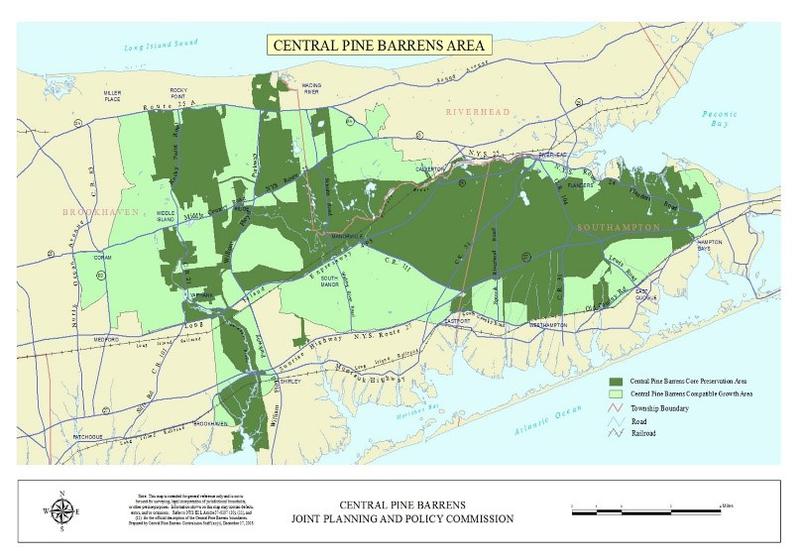In 1993, Governor Mario Cuomo and the New York State Legislature passed the Long Island Pine Barrens Protection Act (the “Act”) in order to protect groundwater, surface water, and drinking water, as well as to preserve Long Island’s significant ecological resource, the Central Pine Barrens. Encompassing over 105,000 acres of land, the Central Pine Barrens are home to one of the few Pine Barren ecosystems in the northeastern United States.

The Act also created the Central Pine Barrens Joint Planning and Policy Commission (the “Commission”), which consists of representatives from New York State, Suffolk County, and the Towns of Brookhaven, Riverhead, and Southampton. One of the mandates of this Commission is to oversee the execution of the Conservation Land Use Plan (the “Plan”), which was put in place in order to prevent disorganized development in the area. This Plan gave rise to the Pine Barrens Credit Program. The intent of this Program is to maintain the value of the protected Pine Barrens lands, protect its ecosystems, and promote more organized development in the region through the distribution of Pine Barren Credits.
What are Pine Barrens Credits and How Do I Get Them?
When a property owner plans to develop or expand a site within the Pine Barrens, a series of approvals must be obtained from Suffolk County and the respective Town. In cases where the proposed project exceeds the density or intensity allowed under applicable zoning and other development regulations, Pine Barrens Credits (PBCs) may come into play during the variance and approvals process.
PBCs are maintained in the Commission’s clearinghouse and reflect ownership of privately-owned properties located within the core preservation area of the Central Pine Barrens Region, or other ecologically sensitive areas identified in the Conservation Land Use Plan. PBCs represent development capacity which can be legally transferred to other parties seeking to gain approvals for development or expansion projects in areas outside of the sensitive core area. Property owners entering into transfer of development rights agreements for PBCs are typically pursuing variances for projects at sites that are at or exceed the allowable development capacity.
PBCs are subject to strict purchase and redemption rules, and development on the protected lands is ultimately restricted under a conservation easement.
How do Pine Barrens Credits Affect Me?
Pine Barrens Credits are a mechanism which allows certain eligible projects which exceed regulatory limits on development to obtain some of the variances and approvals required to proceed. Two common situations involving PBCs are described below:
- Residential developments in designated protected areas are subject to density restrictions which limit the number of single-family dwellings per acre. By purchasing PBCs and preserving sensitive lands in the core area, such developments can exceed the density allowed by code, provided that all other regulatory approvals are obtained and PBC-specific conditions are satisfied.
- Non-residential developments and expansion projects are subject to restrictions set forth by the Suffolk County Department of Health Services on sanitary wastewater discharge flow rates based on the size of the property and the site use. When the proposed design flow exceeds the allowable intensity and a variance is required, PBCs may be purchased and approved for use as sanitary credits, with one PBC typically equivalent to an additional 300 gallons per day of sanitary flow.
When PBCs are redeemed for a project, all other regulatory approvals and requirements apply, in addition to the PBC conditions. PBCs play an important role in protecting the Pine Barrens ecosystem while promoting well-planned development in accordance with environmental regulations.
Walden’s engineers and environmental scientists are experienced in obtaining Suffolk County approvals for various projects. Contact Walden to discuss whether Pine Barrens Credits can help you move forward with your site development or expansion project.
